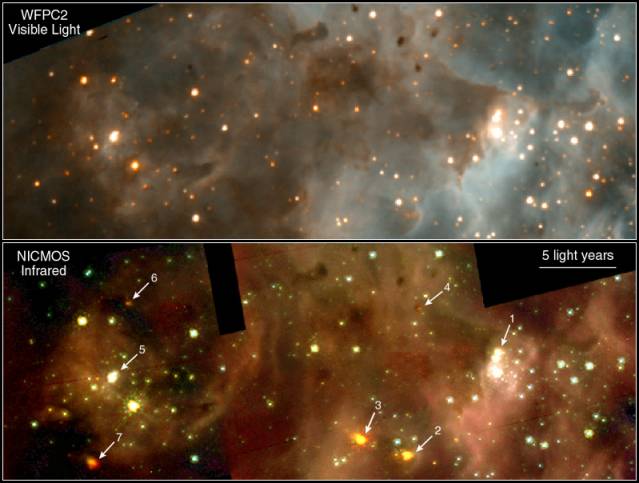Credit & Copyright: John Trauger (JPL),
James Westphal (Caltech),
Nolan Walborn (STScI),
Rodolfo Barba' (La Plata Observatory),
NASA
Explanation:
Compare these
matched Hubble Space Telescope views
(visible-light on top; infrared on bottom) of a region
in the star-forming
30 Doradus Nebula.
Find the numbered
arrows in the infrared image which
identify newborn massive stars.
For example,
arrows 1 and 5 both point to compact clusters of
bright young stars.
Formed within
collapsing gas and dust clouds, the winds and radiation
from these hot stars have cleared away the remaining obscuring material
making the clusters easily apparent in both visible and infrared images.
But still shrouded in dust and readily seen only in the penetrating infrared
view are
newborn stars and star systems
indicated by arrows 2, 3, and 4.
Perhaps even more remarkable are the infrared bright spots indicated
by arrows 6 and 7.
Exactly in a line on opposite sides of the bright cluster at arrow 5,
they may actually be caused by
symmetric jets of material produced
by one of the young cluster stars.
These luminous spots are each about 5 light-years from the
cluster and would
correspond to points at which the
energetic jet material impacts
the surrounding dust clouds.
1999 2000 2001 2002 2003 2004 2005 2006 2007 2008 2009 2010 2011 2012 2013 2014 2015 2016 2017 2018 2019 2020 2021 2022 2023 2024 2025 |
Yanvar' Fevral' Mart Aprel' Mai Iyun' Iyul' Avgust Sentyabr' Oktyabr' Noyabr' Dekabr' |
NASA Web Site Statements, Warnings, and Disclaimers
NASA Official: Jay Norris. Specific rights apply.
A service of: LHEA at NASA / GSFC
& Michigan Tech. U.
|
Publikacii s klyuchevymi slovami:
LMC - star formation - massive stars - 30 Doradus - BMO - Bol'shoe Magellanovo Oblako - zvezdoobrazovanie - Oblasti zvezdoobrazovaniya
Publikacii so slovami: LMC - star formation - massive stars - 30 Doradus - BMO - Bol'shoe Magellanovo Oblako - zvezdoobrazovanie - Oblasti zvezdoobrazovaniya | |
Sm. takzhe:
Vse publikacii na tu zhe temu >> | |
